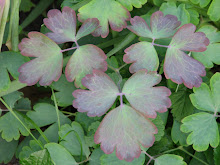Japanese beetles are a definite garden scourge. Their native habitat is in Japan and eastern Russia, where they are not considered invasive. Apparently there's some sort of parasite there that seems to keep them in check. They came here to the U.S. in the early 1900s, on iris bulbs. And they love it here! :)
I hate to spray chemicals in the garden, and even the popular Seven Dust can kill pollinators, like bees. Japanese beetles are fairly slow-moving, and it's easy to pick them from plants and toss them in a container of soapy water as you move through the garden.
Keep a sharp eye out for black powder or accretions on plants. I would've missed this thistle caterpillar on my yarrow without the tell-tale frass.
"Frass" is a fancy word for caterpillar feces. If you see it on leaves, look above it. There's probably a caterpillar eating there!
Thistle caterpillars become Painted Lady butterflies. They're pretty, but I can't have caterpillars killing my plants. I snapped off the stem beneath each caterpillar and squashed the whole lot.
Claudia is great at chasing rabbits out of the new garden and bringing them up to the porch, but she's yet to deposit a deer on our doorstep! We have a lot of deer around here, but so far, we haven't had much damage. We took down the electric fences around the new garden in order to properly plow it, and we're going to put up new fences...but not yet. Sure enough, I found a trail of hoof prints last week, crushing (or almost crushing) several flowers.
Careless hoof prints are destructive, but not as destructive as their teeth.
ARGH! Thankfully, it appeared to be one frisky night, and they haven't been back. But they will, especially as the season heads on toward fall. Good fences help to keep deer out, and so does Milorganite, an organic fertilizer sprinkled around fence perimeters.
Not all predators have four (or eight!) legs. My sedum have been besieged by mildew.
This is a fungal disease that usually proliferates in crowded and wet conditions, although it's been quite dry here for the past few weeks. This is fairly easily treated with a spray of baking soda and water.
To round things out, there's a predatory virus attacking my Black Beauty tomatoes. It's transmitted by a type of fly and causes this tell-tale leaf curling.
Of course, tomato leaf curl might also be caused by too much water...or not enough water...or "general stress." I'll just have to keep an eye on it to make sure it doesn't get worse or start spreading to other plants! The garden always keeps me on my toes!
The biggest pest, to me, is weeds. Check out this strip, where I planted sunflowers, zinnias, cosmos, and nigella. Looks nice and green, right? WEEDS.
Of course, it's common sense that if you plow up a weed patch, add nutrition, full sun, and frequent water, you're going to get weeds. We are ordering mulch, so soon I'll be able to spread wet newspaper in between the plants and mulch the top. Heavy-duty landscaping fabric will cover the paths. This will make a huge difference, because this is much too large to weed by hand!
All of these pests are better taken care of if you spot them right away and start treatment. So far, things haven't been too bad. Hopefully we'll have a relatively pest-free summer!
Otherwise, good things are happening. I've mixed up the labels on my zucchini, watermelon, pumpkins, gourds, cucumbers, and cantaloupes...gulp! But whatever they are, they're starting to flower.
Larkspur is blooming...
...and so is my Cerise Queen yarrow. Yes, it's a major color clash with my Cherry Brandy Rudbeckia, so I'll have to dig it up and move it in the fall.
I didn't like my Pastel Mix yarrow last year, but it's so beautiful now! Pale yellow, pale pink, cream, and darker pink...just really lovely.
You can see it interspersed among the greenery in new front flowerbed that I added last year.
I've gotten some flowering in the new back garden, but...sigh.
I don't like short plants. I have a few, but most of the varieties that I plant range from 2 - 4 feet tall. I love tall, bushy, unrestrained growth! These little zinnias are pretty pathetic.
Another example: this is a Macarenia zinnia that I grew this year.
This is what they're supposed to look like (36" tall).
(photo credit Floret Farms)
I have to face facts: these seedlings sat for too long in their pots, and are completely stunted. They aren't going to do anything this year, and I can't save their seeds, because seeds from unhealthy, wimpy plants have a very good chance of producing a new generation of unhealthy, wimpy plants. It's a bitter disappointment, BUT I have learned a lot of invaluable lessons this spring. I feel very capable of doing some amazing things next year and have a huge flower garden that's blazing with color! This year I'll focus on improving the soil and keeping down the weeds, and I'll continue to amuse myself by thinking that the turkey vultures that are frequently lurking over the garden are ready to swoop in for the kill on these pathetic plants. Can't you just see a helpless bundle of droopy sunflowers clutched in his talons? :)



























I’ve enjoyed reading your blog and the photos. I’ll try the baking soda remedy on my mildew covered peonies. Look into milky-spore for ridding your yard of Japanese beetle larvae. We bought a Deer Guard which emits a sound the deer don’t like and which we don’t hear. Seems to be working except not for moles, raccoons, skunks, chipmunks, ground hogs and squirrels. Oh, the joy of country living!
ReplyDelete